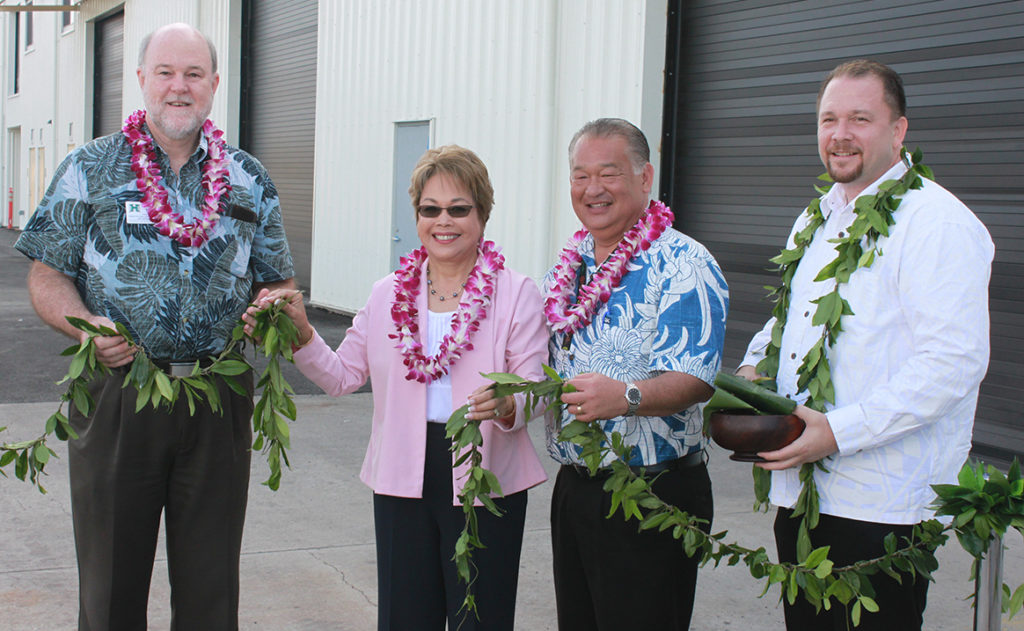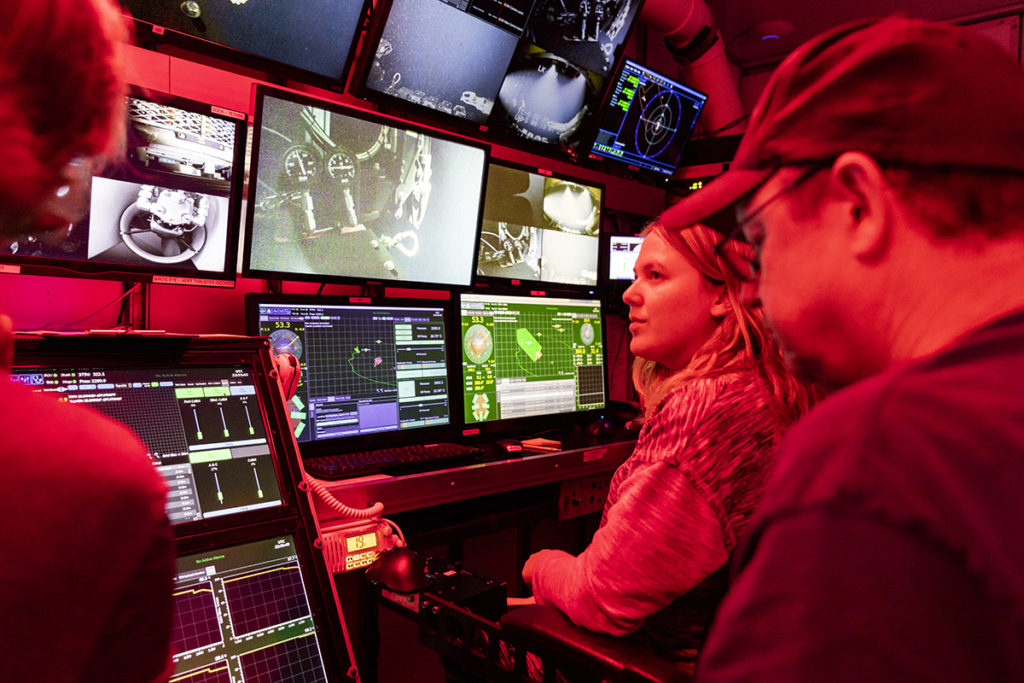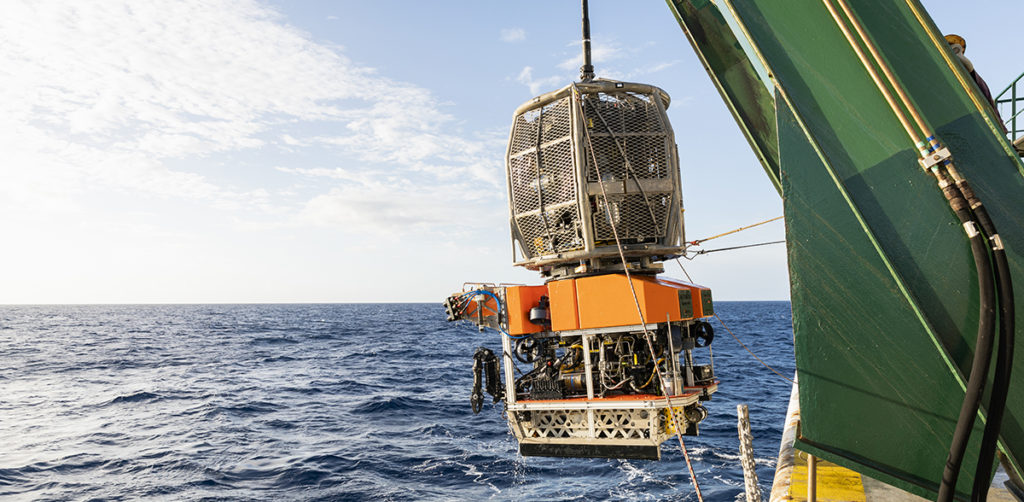A Nexus of Research, Innovation and Collaboration
The University of Hawai‘i (UH) is a world-renowned hub for international research in the Pacific Ocean. Geographically, scientifically and operationally, the University of Hawai‘i Marine Center (UH Marine Center) is the fulcrum of oceanographic research expeditions to investigate deep sea volcanic activity, open ocean microbes critical to our planet’s health, the diverse and thriving communities of the Papahanaumokuakea Marine National Monument, and more.

Since the 1970’s the UH Marine Center operated from Pier 45, often called Snug Harbor. As part of the State of Hawai‘i Department of Transportation’s (HDOT) Harbors Modernization Plan to increase container terminal space at the state’s busiest commercial harbor, the UH Marine Center operations were moved to Pier 35 in 2016. A $17-million HDOT Harbors Division renovation project of the facility provided 800 feet of pier space to service up to three ships, new office and laboratory facilities, and additional warehouse and outside storage space for containers and weatherproof equipment. After moving into the new facility, UH made additional improvements and integrated the facility into the University of Hawai‘i at Mānoa (UH Mānoa) campus IT infrastructure. The combined upgrades will serve the UH Marine Center well over the next several decades and help ensure that it will continue to support state-of-the-art research.
“The foremost responsibility of the UH Marine Center,” said Anita L. Lopez, director of Research Vessel Operations, “is to support the R/V Kilo Moana, a 186-foot U.S. Navy-owned research vessel that UH operates under a charter party agreement with the Office of Naval Research.”
Since it arrived in Honolulu in 2002, the R/V Kilo Moana has conducted oceanographic research throughout the Pacific Basin and averages about 220 days at sea each year. The ship is equipped to conduct physical, biological and chemical oceanography, as well as geological investigations of the seafloor and geophysical sensing of the Earth’s structure beneath.
Ocean robotics and submersible technology are pushing the frontiers of discovery. The UH remotely operated vehicle (ROV) Lu‘ukai is a small work-class ROV that can be operated from the R/V Kilo Moana to conduct investigations in waters up to 6,000 meters deep. After beginning operations in early 2018, the Lu‘ukai has supported a study of deep-sea biodiversity and ecological processes in the western Clarion-Clipperton Zone, an area where numerous manganese nodule mining exploration claims are located; has maintained and upgraded sensors at the ALOHA Cabled Observatory, the world’s deepest operating ocean observatory; and has recovered a failed telecommunications cable used to support acoustic research in local waters.
Additionally, the UH Marine Center directly supports research through available on-site, shore-side laboratories. The Center for Microbial Oceanography: Research and Education team maintains a small fleet of autonomous underwater and surface vehicles and occupies several laboratories to processes samples, including those collected through the Hawai‘i Ocean Time-series, a 30-year monitoring and research program that provides an unprecedented view of the key role microbes play in the health of the oceans and atmosphere.

The UH Marine Center also hosts other research vessels operating in the Central Pacific, especially those in the U.S. Academic Research Fleet, as well as those operated by a number of private philanthropies. These hosted vessels bring along their crew members, equipment and scientists, providing UH with expanded expeditionary and scientific opportunities and collaborations.
Sustainability and Stewardship
In addition to supporting environmental research, the UH Marine Center strives to be a responsible environmental steward. In 2018, 542 photovoltaic panels and batteries were installed with the goal of reducing the Center’s yearly electricity bill of about $75,000. The project, which includes data monitoring and analysis equipment and technology, was completed in collaboration with the Hawai‘i Natural Energy Institute (HNEI), a research institute within the UH Mānoa School of Ocean and Earth Science and Technology. The excess energy output from the HNEIPV system will also feed the overall UH Marine Center, contributing to UH and the state of Hawai‘i’s energy goal to become net zero by the year 2035. HNEI also leads GridSTART (Grid System Technologies Advanced Research Team) which is focused on the integration and analysis of energy technologies and power systems, including smart grid and micro grid applications.
That same year, Ross Barnes, marine operations superintendent of the UH Marine Center, was honored by HDOT Harbors Division as Tenant Environmental Manager of the Year. The DOT, annual award recognizes exemplary environmental and safety practices, in addition to continued efforts to implement and maintain post-construction best management practices. Barnes recently retired in March 2020, after 41 years of dedicated and exemplary service to UH.

End of an Era, Looking Ahead to the Future
In late 2019, the 223-foot R/V Ka‘imikai-O-Kanaloa was retired from service. Affectionately known to many as the K-O-K, the ship joined the fleet of UH marine expeditionary research vessels on January 15, 1994. Since then, K-O-K was used extensively across the Pacific Ocean on a variety of missions that included submersible operations, deployment of deep-sea moorings, hydrographic surveys and studies of marine biology, chemistry and climate change.
“The University of Hawai‘i is best positioned regionally to provide research vessel services to federal, state and private entities without having the carbon footprint impacts of repositioning like vessels from the east or west coast,” said Lopez. “With the retirement of the K-O-K, a search for a new research vessel has begun. We have a perfect opportunity to invest in the state’s infrastructure and provide another world-class platform to meet the demand for ocean exploration, deep-sea biodiversity and climate research.”
A Leader Focused on Supporting Science and Society
Prior to joining the UH Marine Center two years ago, Lopez was the deputy director of Operations at the Office of Marine and Aviation Operations and deputy director of the NOAA Commissioned Officer Corps for the National Oceanic and Atmospheric Administration (NOAA). She was responsible for the operations of NOAA’s nine aircraft and sixteen research vessel fleet and approximately 1,000 employees operating across the country. A seasoned mariner, she has had over nine years of underway shipboard bridge experience and sailed as captain of the NOAA Ship Oscar Elton Sette, a fisheries research vessel homeported at Joint Base Pearl Harbor-Hickam.
In her leadership role at the UH Marine Center, Lopez is focusing on providing world-class support and services to mission partners, meeting all research mission objectives, investing in her team, and ensuring operations are conducted safely and efficiently. “We have an amazing team of professional mariners, technicians, and administrative staff that love what they do and enjoy being part of contributing to the learning of our environment and ensuring the sustainability of our natural resources,” said Lopez.
Her experiences working in Hawaiian waters, including the Papahanaumokuakea Marine National Monument, and sharing the opportunities of research and science with local children inspired her to return to Hawai‘i to contribute to the education of the state’s youth, as well as provide world-class research vessel services for the research community.
“I am thrilled about returning to Hawai‘i and excited about being a part of the many services we provide for the research community and the state,” she added.

